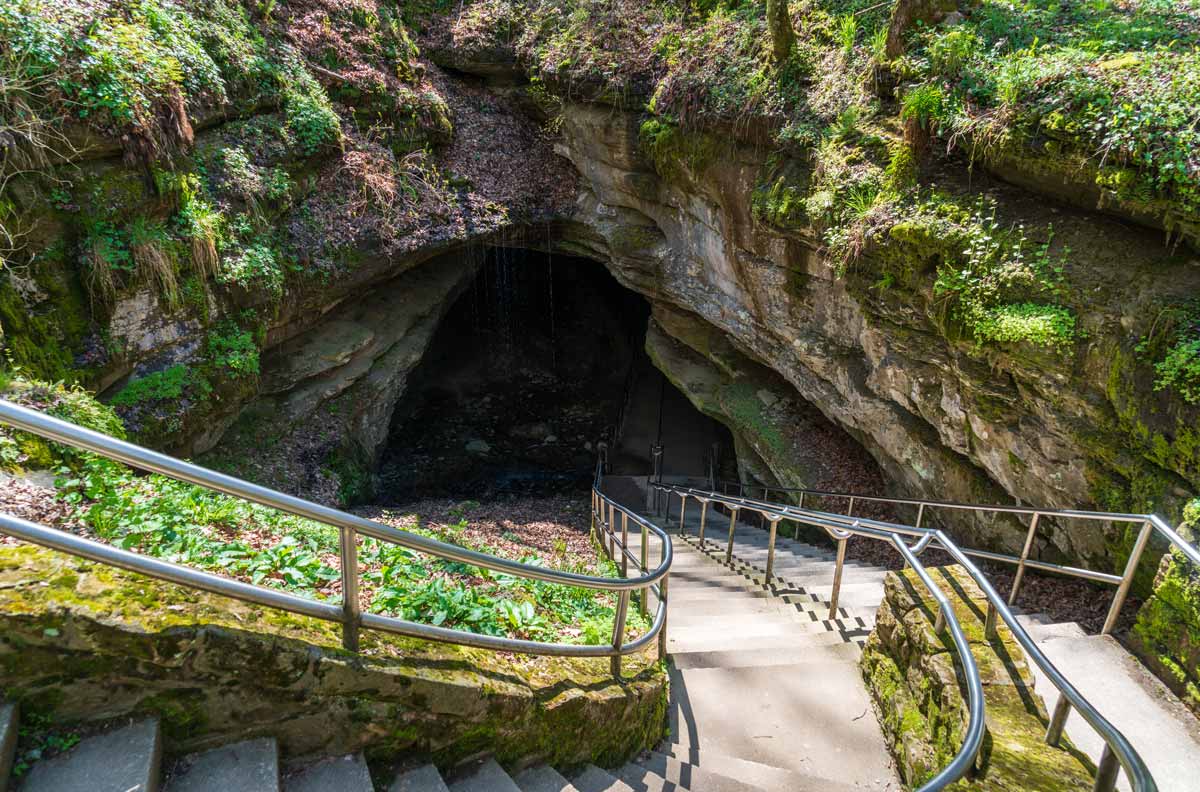Caves are magnets for me. I’m attracted to their otherworldly formations and unique histories and to the mysteries that exude from within their walls.
I feel like Indiana Jones as I sidle through the dark subterranean passageways with only a dimly lit lantern or flashlight. It’s an eerie yet fascinating experience.
FORMATION OF THE CAVE
Mammoth Cave National Park in Kentucky contains the world’s longest known cave system, with more than four hundred miles explored and mapped to date.
No one knows exactly how far deep it goes, as an estimated 600 miles of passages are still unexplored. This vast geological wonder was formed millions of years ago as limestone dissolved in water seeping through the ground.
In simple terms, there are two layers of stone under the topsoil of the hills of southern Kentucky. The upper is made of sandstone, which acts like an umbrella, covering the lower layer of limestone. There are also places called sinkholes, where the surface water is able to penetrate the upper layer of sandstone.
This causes the limestone on the lower layer to erode, which then forms the various structures that comprise the cave.
Mammoth Cave is officially recognized as the second largest tourist attraction in the U.S., right behind famed Niagara Falls. During peak times, over 4,000 people visit and tour the caves daily.
HUMAN HISTORY OF THE CAVE
The cave has a lengthy and storied history beginning with the native peoples of North America, who began exploring it more than 4,000 years ago and used it as a shelter during harsh weather.
Mummified and skeletal remains, as well as pottery and primitive tools, have been found in different parts of the cave, providing proof of human occupation. Research indicates that these people only went about twenty miles into the cave.
European settlers rediscovered the cave in the late 1700s and then, during the War of 1812, enslaved laborers mined Mammoth for nitrates to be processed into saltpeter for ammunition. A few years later, the place opened up for tours.
What many people don’t know is that most of the important guides and explorers of the cave in the 19th and early 20th centuries were African American. It was actually slaves that began leading the tours, giving visitors the opportunity to examine the inside of the cave with oil lamps and torches. They were even allowed to “smoke” their names into the limestone, some which can still be seen today.
A PIONEERING SPELUNKER MAKES HIS MARK ON THE CAVE
The most famous of these enslaved guides was Stephen Bishop. Without Bishop, it’s unclear how much of the cave we would know about today, as this pioneering spelunker mapped out many of the underground system’s popular sites.
Bishop was seventeen when he was brought to the cave by his owner, Franklin Gorin, a lawyer who wanted to turn the place into a tourist attraction. Bishop traversed a complex rabbit warren full of sinkholes, cracks, boulders, domes and underwater springs, as he discovered tunnels and caverns using only ropes and a lantern.
He quickly became an expert on Mammoth Cave and the map he made by memory of this behemoth was used for decades.
Story has it that when one visitor offered Bishop a lot of money to take him somewhere new, he decided to cross the 105-foot Bottomless Pit, a cavern so deep torches disappear when thrown into it. He placed a ladder across the pit and crawled to the other side, carrying the lantern in his teeth.
Another time, he discovered what is known as Fat Man’s Misery, an ancient riverbed with narrow, winding passages. It was so full of silt that Bishop had to dig his way through and the further he went, the lower the ceiling became until he found himself in Tall Man’s Misery. When he emerged, he was finally able to stand up in an area named the Great Relief Hall.
HAUNTED TALES AND TB PATIENTS
Numerous people have died in the cave over the decades, including slaves and tuberculosis patients, but the exact number of deaths is unknown. For this reason, Mammoth is regarded as a haunted realm and many people have claimed to sense spirits, or have unexplained objects appear in their photos.
As for the TB patients, they were part of an experiment conducted by Dr. John Croghan in 1842. Dr. Croghan, who suffered from the disease himself, purchased the cave and hoped the environment would be restorative and therapeutic for TB patients.
He based his idea on the fact that visitors and miners had reported feeling well after spending time in the cave. The doctor had also observed that timber and animals did not decay within the cave.
Armed with this evidence, the good doctor invited sixteen patients to take up residence in the cave within stone cabins and simple wooden structures constructed for this purpose.
Initially, the patients seemed to improve and Dr. Croghan began to draw up plans for a hotel in the cave to house the anticipated throngs that would flock to the cave to be healed.
However, as time progressed, it became obvious that the dark, unventilated, damp conditions, along with the smoke and ash from the lard oil lanterns, worsened the patients’ symptoms. One enslaved man, who worked as a food server, noted that the patients looked like “a company of skeletons.”
Several patients ultimately died inside the cave and the experiment ended after five months. Like his patients, Dr. Croghan also passed away of the disease a few years later.
HEAR THE STORY OF FLOYD COLLINS WHO BECAME NATIONAL NEWS
The most notable death in the cave, however, was that of Floyd Collins in 1925. Floyd became trapped while mapping out and exploring a previously undiscovered section. As he squeezed through tight spots, inching along on his stomach, his lantern began to flicker.
Knowing how dangerous it could be to lose light in a cave, Floyd opted to head back. But along the way, his foot dislodged a 27-pound rock which wedged his ankle in place. Unable to remove his foot, he was trapped.
Rescue efforts began and various professionals were called in from all over the state. When conventional means were exhausted, miners started digging a shaft to reach Floyd. Throughout a period of seventeen days, curious onlookers descended on the area en masse, creating a “carnival atmosphere” with vendors selling food, drinks and souvenirs.
The news became a national story. On the eighteenth day, rescuers finally reached Floyd, but unfortunately it was too late, as Floyd had died of exposure.
This tragic tale served a purpose, as it drew the nation’s attention to Kentucky’s cave country and the desire to protect and preserve it. It eventually led to the establishment of Mammoth Cave National Park in 1941. And then in 1981, the park received World Heritage Site and was ultimately designated an International Biosphere Reserve in 1990.
EXPLORE THE CAVE ON A GUIDED TOUR
Today, you can explore Mammoth Cave via a series of guided tours, ranging from short and long walking excursions to evening lantern tours and adventurous crawling experiences.
There’s also a fully wheelchair-accessible tour. Some of the tours emphasize the formations, like stalactites, white gypsum flowers and draperies. Others, like the popular Historic Tour, visit many of the historic areas that originally made the cave famous.
During the Historic Tour, you’ll go through tunnels that have been used for thousands of years and explore the ginormous rooms that gave the cave its name.
You’ll ascend and descend hundreds of stairs and steep inclines, as well as stoop down and around to move through tight and narrow places deep inside the cave, like the aforementioned Tall Man’s Misery and Fat Man’s Misery.
And yes, you’ll cross over the same Bottomless Pit, which has a depth of about 105 feet. It’s just beyond the rockfall known as Giant’s Coffin. You got to love the doom and gloom names!
Bats still flutter about in the cave or appear as tiny black spots on the walls. Sounds echo through the caverns. And when your guide turns off his lantern, it’s spooky dark. You can only imagine the challenges of trying to creep along the cave floor in pitch black conditions.
You’ll come away with plenty of information and colorful stories, as well as an appreciation for the early spelunkers, who are responsible for courageously charting passageways through the cave so that we can enjoy it today.

